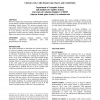Free Online Productivity Tools
i2Speak
i2Symbol
i2OCR
iTex2Img
iWeb2Print
iWeb2Shot
i2Type
iPdf2Split
iPdf2Merge
i2Bopomofo
i2Arabic
i2Style
i2Image
i2PDF
iLatex2Rtf
Sci2ools
CHI
1998
ACM
1998
ACM
Adapting User Interface Design Methods to the Design of Educational Activities
considered simply, but a more complex evaluation of the effects of performing the tasks. For example, an educational activity that learners complete quickly and accurately is of no value if they learn nothing from it. We have adapted the programming walkthrough technique to help design computer-supported educational activities in elementary school science. We present examples from a case study which illustrate ways in which design of an educational activity is similar to and different from design of a user interface. We have found that the walkthrough approach is useful in this new setting, and that it sheds new light on the general task-centered orientation to design. Despite these differences in design problems, we hypothesized that the core logic of task-centered user interface design, and of the associated walkthrough methods, could be adapted to the design of educational activities. We present the results of our exploration of this possibility by describing a case study in which w...
CHI 1998 | Educational Activities | Elementary School Science | Human Computer Interaction | Programming Walkthrough Technique |
| Added | 05 Aug 2010 |
| Updated | 05 Aug 2010 |
| Type | Conference |
| Year | 1998 |
| Where | CHI |
| Authors | Clayton Lewis, Cathy Brand, Gina Cherry, Cyndi Rader |
Comments (0)

